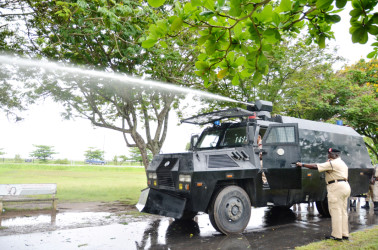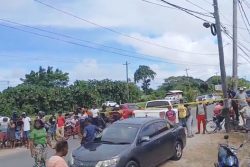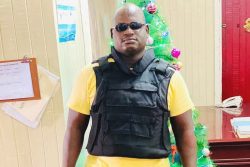The Guyana Police Force has spent over $1 million on the maintenance of the $20.8 million water cannon to date but has never been able to use it for the purpose for which it was purchased; it has been recommended that it be used as fire-fighting equipment.
According to the report of a forensic audit into the acquisition of the water cannon truck purchased by the former PPP/C government, though the equipment was purchased for far less than the amount budgeted for it, there was no value for money, since it has not served the purpose for which it was acquired.
In 2010, then home affairs minister Clement Rohee requested the cannon for purposes of crowd control in the 2011 General and Regional elections.

Chartered accounting firm Nizam Ali and Company was retained by the APNU+AFC government which took office last year, to carry out a forensic audit of the acquisition of this equipment.
The audit report noted that while then permanent secretary of the ministry Angela Johnson suggested the allocation of $37 million towards the acquisition of the cannon, she had advised that the sum may not be adequate.
According to the report, the auditors found that the cost of a reconditioned cannon is in excess of $63 million, while the price for a new one stood at $90 million.
In December 2010, the cannon was purchased for $ 20,800,000 from Shiyan Yunlihong Industrial and Trade Co Ltd in China. The used cannon arrived in the country one year later.
The auditors noted that there was no available evidence of a study or evaluation to determine the need for the equipment nor was there any study to determine the merit of that particular type of equipment.
The auditors said the Guyana Police Force (GPF) had informed that the force had not been consulted on the purchase or selection of water cannon.
According to the report, the equipment could not be deployed during the Linden protest in July 2012, even though it was summoned, as the nature of the operation and terrain made it unsuitable. It said too that during October 2012 protest in Agricola, the truck was also summoned, but it was determined that it was unsuited for that particular operation since it was engaging a moving and not stationary crowd.
At a demonstration of how the cannon works, auditors said that while they were able to observe that all the components relating to intake of water, rotation of the water sprout, spraying of water and engagement of self-protection water jets were functional, they were unable to assess the use of the other components since lachrymatory liquid dyes were not present.
They revealed too that there was no indication that an inspection was done on the cannon to ensure that the item supplied was consistent with what was ordered.
Noting that the warranty for the cannon was 12 months or 20,000km (subject to whichever came first), the report said that there was no evidence that sufficient testing was done during the warranty period.
It added that there were no records of the mileage reading on the odometer on arrival of the cannon.
The report said that during a meeting with the GPF, Assistant Commissioner of Police David Ramnarine indicated that the cannon “may not be suitable for crowd dispersal in Guyana since it may be difficult to manoeuvre this truck in our city due to the streets not being wide enough, also the use of it is likely (to) damage surrounding buildings.”
Since its arrival, the GPF has spent $1,051,560 on its maintenance. In its recommendation, the auditors said that the GPF should carry out an assessment on the usefulness of the water cannon, and determine whether the cost of maintaining it will justify any future potential benefit.
It recommended too that the acquisition of specialised equipment for the GPF, should be properly evaluated and that consultation should be held with senior members of the force with requisite knowledge to determine the need for such equipment.
Where equipment is purchased under warranty, there should be sufficient testing of the equipment during the warranty period, to determine whether there are any malfunctioning components. The auditors said that on arrival of equipment there should be a thorough examination of equipment and that evidence of the examination should be documented.
The report added that consideration should be given to the use of the cannon as a fire fighting tool, or any other alternative use as it appears it will be of little use to the GPF.







